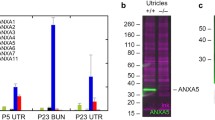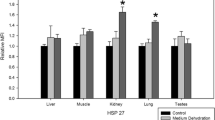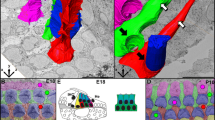Abstract
Sea anemones were subjected to mild trauma consisting of a 2 min immersion in calcium-depleted seawater. The trauma caused a loss of vibration sensitivity that spontaneously recovered within 50 min of returning the anemones to calcium containing seawater. Apparently, recovery is conferred by proteins contained in fraction gamma, a chromatographic fraction of homogenized mucus collected at the base of anemones allowed to recover from similar trauma. On silver stained SDS-PAGE gels, fraction gamma consists of a single band having an estimated mass of 55 kDa. Fraction gamma is alone sufficient to repair hair bundle mechanoreceptors in anemones. Its biological activity is enhanced in the presence of exogenously supplied ATP, but not GTP nor ADP-ribose. Biotinylated fraction gamma binds to hair bundles. The hypothesis that fraction gamma consists of Hsp60 proteins was tested. Commercial antibodies to Hsp60 label a band at 55 kDa in western blots. Hsp60 antibodies label hair bundles in traumatized anemones but not in untreated controls. Dilute Hsp60 antiserum (but not nonimmune serum) delays the spontaneous recovery of vibration sensitivity in anemones subjected to mild trauma. Thus, fraction gamma likely consists of Hsp60, or a Hsp60-like protein, that functions on the extracellular face of the plasma membrane to restore function to traumatized hair bundles.








Similar content being viewed by others
References
Assad JA, Shepherd GM, Corey DP (1991) Tip-link integrity and mechanical transduction in vertebrate hair cells. Neuron 7:985–994
Bayer EA, Wilchek M (1990) Protein biotinylation. Methods Enzymol 184:138–160
Berg A, Watson GM (2002) Rapid recovery of sensory function in blind cave fish treated with anemone repair proteins. Hear Res 174:296–304
Chitaev NA, Troyanovsky SM (1998) Adhesive but not lateral E-cadherin complexes require calcium and catenins for their formation. J Cell Biol 142:837–846
Crawford AC, Evans MG, Fettiplace R (1991) The actions of calcium on the mechano-electrical transducer current of turtle hair cells. J Physiol 434:369–398
Frostegard J, Pockley AG (2005) Heat shock protein release and naturally occurring exogenous heat shock proteins. In: Henderson B, Pockley AG (eds) Molecular chaperones and cell signalling. Cambridge University Press, New York, pp 195–219
Gale JE, Marcotti W, Kennedy HJ, Kros CJ, Richardson GP (2001) FM1-43 dye behaves as a permeant blocker of the hair cell mechanotransducer channel. J Neurosci 21:7013–7025
Gale JE, Piazza V, Ciubotaru CD, Mammano F (2004) A mechanism for sensing noise damage in the inner ear. Curr Biol 14:526–529
Goodyear R, Richardson GP (1999) The ankle-link antigen: An epitope sensitive to calcium chelation associated with the hair cell surface and the calycal processes of photoreceptors. J Neurosci 19:3761–3772
Harrison OJ, Corps EM, Kilshaw PJ (2005) Cadherin adhesion depends on a salt bridge at the N-terminus. J Cell Sci 118:4123–4130
Kachar B, Parrakal M, Kurc M, Zhao Y, Gillespie PG (2000) High-resolution structure of hair-cell tip-links. Proc Natl Acad Sci USA 97:13336–13341
Mariscal RN (1974a) Nematocysts. In: Muscatine L, Lenhoff HM (eds) Coelenterate biology, reviews and new perspectives. Academic, New York pp 129–178
Mariscal RN (1974b) Scanning electron microscopy of the sensory surface of the tentacles of sea anemones and corals. Z Zellforsch Mikrosk Anat 147:149–156
Meyer J, Furness D, Zenner HP, Hackney CM, Gummer AW (1998) Evidence for opening of hair-cell transducer channels after tip-link loss. J Neurosci 18:6748–6756
Michel V, Goodyear RJ, Weil D, Marcotti W, Perfettini I, Wolfrum U, Kros CJ, Richardson GP, Petit C (2005) Cadherin 23 is a component of the transient lateral links in the developing hair-bundles of cochlear sensory cells. Dev Biol 280:281–294
Minasian LL Jr, Mariscal RN (1979) Characteristics and regulation of fission activity in clonal cultures of the cosmopolitan sea anemone, Haliplanella luciae (Verrill). Biol Bull 157:478–493
Mire-Thibodeaux P, Watson GM (1994) Morphodynamic hair bundles arising from sensory cell/supporting cell complexes frequency-tune nematocyst discharge in sea anemones. J Exp Zool 268:281–292
Munoz DJB, Thorne PR, Housley GD, Billet TE (1995) Adenosine 5’-triphosphate (ATP) concentrations in the endolymph and perilymph of the guinea pig cochlea. Hear Res 90:119–125
Pertz O, Bozic D, Koch AW, Fauser C, Brancaccio A, Engel J (1999) A new crystal structure, Ca2+ dependence and mutational analysis reveal molecular details of E-cadherin homoassociation. EMBO J 18:1738–1747
Peteya DJ (1975) The ciliary-cone sensory cell of anemones and cerianthids. Tissue Cell 7:243–252
Repass JJ, Watson GM (2001) Anemone repair proteins as a potential therapeutic agent for vertebrate hair cells: Facilitated recovery of the lateral line of blind cave fish. Hear Res 154:98–107
Sand O (1975) Effects of different ionic environments on the mechano-sensitivity of the lateral line organs in the mud-puppy. J Comp Physiol Ser A 102:27–42
Siemens J, Lillo C, Dumont RA, Reynolds A, Williams DS, Gillespie PG, Muller U (2004) Cadherin 23 is a component of the tip link in hair-cell stereocilia. Nature 428:950–955
Sollner C, Rauch GJ, Siemens J, Geisler R, Schuster SC, Muller U, Nicolson T, Tubingen 2000-Screening Consortium (2004) Mutations in cadherin 23 affect tip links in zebrafish sensory hair cells. Nature 428:955–959
Sotomayor M, Corey DP, Schulten K (2005) In search of the hair cell gating spring: elastic properties of ankyrin and cadherin repeats. Structure 13:669–682
Tsuprun V, Goodyear RJ, Richardson GP (2004) The structure of tip links and kinocilial links in avian sensory hair bundles. Biophys J 87:4106–4112
Watson GM, Hessinger DA (1987) Receptor-mediated endocytosis of a chemoreceptor involved in triggering the discharge of cnidae in a sea anemone tentacle. Tissue Cell 19:747–755
Watson GM, Hessinger DA (1989) Cnidocyte mechanoreceptors are tuned to the movements of swimming prey by chemoreceptors. Science 243:1589–1591
Watson GM, Hudson RR (1994) Frequency and amplitude tuning of nematocyst discharge by proline. J Exp Zool 268:177–185
Watson GM, Mire P (2001) Reorganization of actin during repair of hair bundle mechanoreceptors. J Neurocytol 30:895–906
Watson GM, Mire P (2004) Dynamic tuning of hair bundle mechanoreceptors in a sea anemone during predation. Hydrobiologica 530/531:123–128
Watson GM, Roberts J (1994) Localization of proline receptors involved in regulating nematocyst discharge. J Exp Zool 270:527–537
Watson GM, Mire P, Hudson RR (1997) Hair bundles of sea anemones as a model system for vertebrate hair bundles. Hear Res 107:53–66
Watson GM, Mire P, Hudson RR (1998a) Repair of hair bundles in sea anemones by secreted proteins. Hear Res 115:119–128
Watson GM, Mire P, Hudson RR (1998b) Frequency specificity of vibration dependent discharge of nematocysts in sea anemones. J Exp Zool 281:582–593
Watson GM, Venable S, Hudson RR, Repass JJ (1999) ATP enhances repair of hair bundles in sea anemones. Hear Res 136:1–12
Watson GM, Graugnard EM, Mire P (2007) The involvement of Arl-5b in the repair of hair cells in sea anemones. JARO 8:183–193
Zhao Y, Yamoah EN, Gillespie PG (1996) Regeneration of broken tip links and restoration of mechanical transduction in hair cells. Proc Natl Acad Sci USA 94:15469–15474
Acknowledgments
We gratefully acknowledge financial support of this project by the NOHR Foundation and NSF IOB0542574.
Author information
Authors and Affiliations
Corresponding author
Rights and permissions
About this article
Cite this article
Nag, K., Watson, G.M. Repair of hair cells following mild trauma may involve extracellular chaperones. J Comp Physiol A 193, 1045–1053 (2007). https://doi.org/10.1007/s00359-007-0255-5
Received:
Revised:
Accepted:
Published:
Issue Date:
DOI: https://doi.org/10.1007/s00359-007-0255-5




